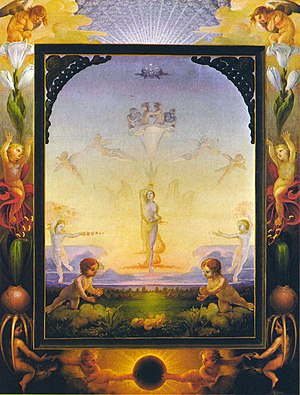The morning (painting)

|
| The morning |
|---|
| Philipp Otto Runge (1777–1810) , 1808 |
| Oil on canvas |
| 109 × 85.5 cm |
| Hamburger Kunsthalle |
The morning is an oil painting by Philipp Otto Runge , of which two versions exist. It is one of the most famous works of romantic painting.
Emergence
Runge probably planned an allegorical cycle of the times of day as early as 1803 . Several sketches for the planned cycle were made by 1807 . The first version of the morning in oil , which is often referred to as The Little Morning , he completed in 1808. The second, unfinished version, called The Big Morning , was created in 1809, but has only survived in fragments. Due to Runge's early death, he could no longer implement the planned cycle. Both versions are in the Hamburger Kunsthalle .
Description and interpretation
The picture represents a transfigured landscape, over which a sky interwoven with various colors arches at dawn. The center of the picture is taken by a female nude figure who seems to rise up into the sky. You may as Aurora , Venus or Maria are interpreted. A flower blooms out of her hand and extends into the twilight sky. It is probably a lily that can be seen as a symbol of purity and transfiguration. Heaven and earth are enriched with putti and children's figures, which probably symbolize the purity and innocence of the early day. The child lying in the middle of the earth is supposed to represent Christ , the incarnation of God and the light of the world. There is a frame around the main painting in which other children's figures and plants can be seen. Below the frame shows a solar eclipse, above a choir of angels in the glow of lights.
Runge's quote "Tomorrow is the boundless enlightenment of the universe" is probably the most important hint for interpretation. Strongly influenced by the mystic Jakob Böhme and the early romantic poet Novalis , Runge tried in the morning to portray a romantic-mystical vision of the universe. The transfigured landscape and the allegorical figures become carriers of a romantic world vision that becomes particularly clear in the blurring of the boundaries between night and day. The influence of Novalis can be seen, for example, in Runge's choice of topics: The morning with its “very pleasant light” had already been addressed by Novalis in his hymns to the night . The symbolism also shows similarities to Novalis, as the lily that grows up into the sky is reminiscent of the blue flower .
From an artistic point of view, the strictly symmetrical structure of the picture, which is atypical for Romanticism, is striking. The putti and figures of children are still vaguely reminiscent of the Baroque . The surrealistic depictions of plants are likely to be inspired by Hieronymus Bosch .
literature
- Frank Büttner: Philipp Otto Runge , CH Beck Verlag Munich 2010. ISBN 978-3-406-60092-0
- Wolf Stubbe: Philipp Otto Runge - image and symbol , R. Piper & Co. Verlag, Munich 1977, ISBN 3-492-02269-3
- Stephan Waetzoldt: The heavenly child in Ph. O. Runge's “Tomorrow”. In: Lichtwark No. 2. Ed. Bergedorf District Office, Bergedorf, 1950. See now: Verlag HB-Werbung, Hamburg-Bergedorf. ISSN 1862-3549 .
- Norbert Wolf: Romanticism , Taschen Verlag Cologne. ISBN 978-3-8228-5307-8